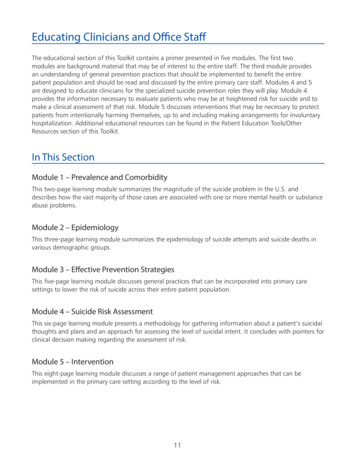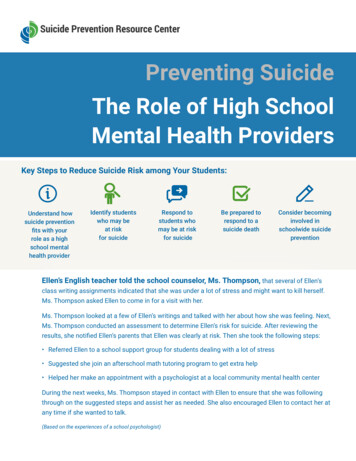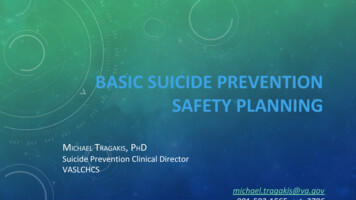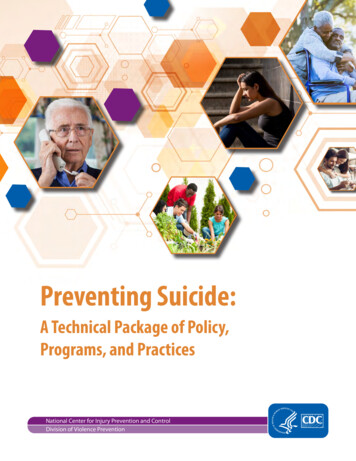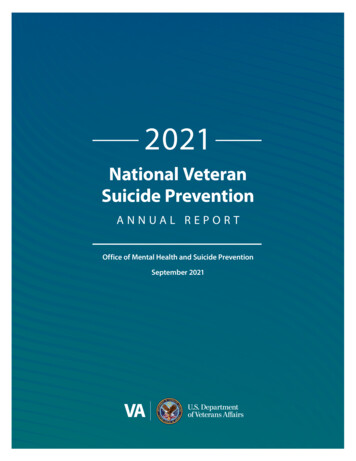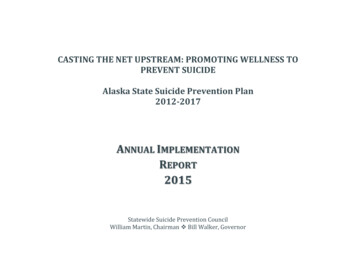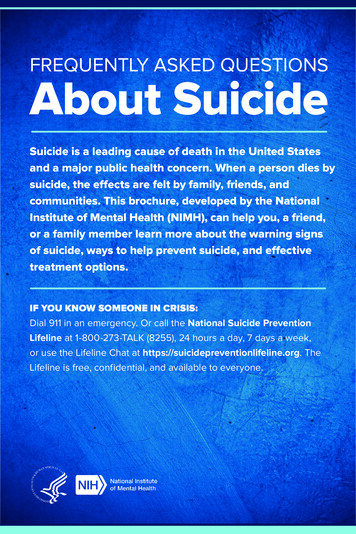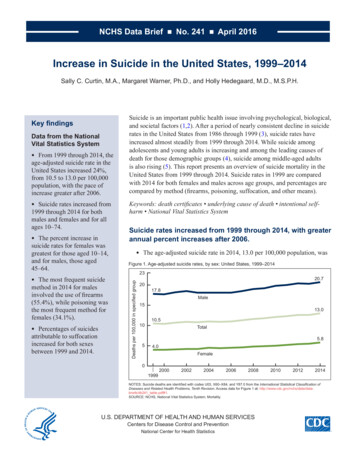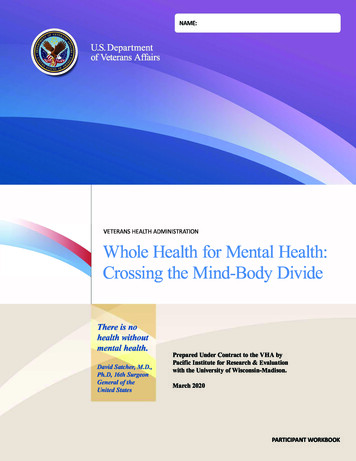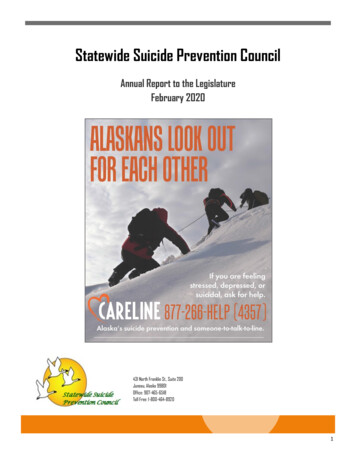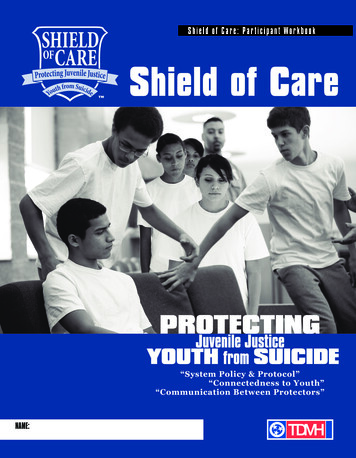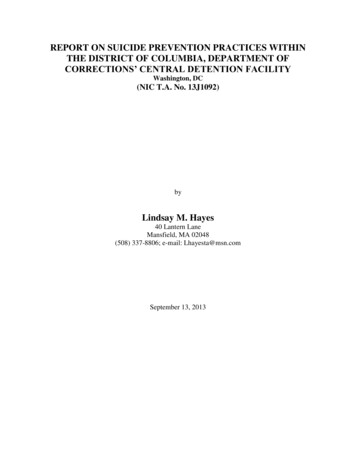
Transcription
REPORT ON SUICIDE PREVENTION PRACTICES WITHINTHE DISTRICT OF COLUMBIA, DEPARTMENT OFCORRECTIONS’ CENTRAL DETENTION FACILITYWashington, DC(NIC T.A. No. 13J1092)byLindsay M. Hayes40 Lantern LaneMansfield, MA 02048(508) 337-8806; e-mail: Lhayesta@msn.comSeptember 13, 2013
2REPORT ON SUICIDE PREVENTION PRACTICES WITHIN THE DISTRICT OFCOLUMBIA, DEPARTMENT OF CORRECTIONS’ CENTRAL DETENTIONFACILITYWashington, DC(NIC T.A. No. 13J1092)A.INTRODUCTIONThe following is a summary of the observations, findings, and recommendations ofLindsay M. Hayes, Project Director of the National Center on Institutions and Alternatives,following the provision of short-term technical assistance to the District of Columbia,Department of Corrections’ (DOC) Central Detention Facility (CDF). As of August 2013, theCDF has experienced a much higher number (three) of inmate suicides than in previous years.Because of the higher incidence of suicide, the DOC and its health care provider (Unity HealthCare) began to examine the deaths, as well as review various policy and procedural directivesrelating to suicide prevention. In order to independently assess current practices, as well as offerany appropriate recommendations to suicide prevention policies and procedures within the CDF,DOC Director Thomas Faust decided to seek the assistance of an outside consultant. Throughthe technical and financial assistance of the National Institute of Corrections - Jails Division, thiswriter’s consulting services were offered to, and selected by, Director Faust.It should be noted that the determination for the need of this writer’s assessment was notprompted by litigation or critical investigation of any of the recent inmate suicides. Rather, theseactions were taken through the pro-active initiative of Director Faust who was committed todetermining what steps, if any, were necessary to improve suicide prevention practices within theCentral Detention Facility.
3In conducting the assessment, this writer met with and/or interviewed numerouscorrectional, medical, and mental health officials and staff from the DC Department ofCorrections, Central Detention Facility, and Unity Health Care; reviewed numerous policies andprocedures related to suicide prevention, and screening/assessment protocols; reviewed varioushealth care charts and investigative reviews of three (3) inmate suicides between November 2012and June 2013;1 and toured the Central Detention Facility.The on-site assessment wasconducted on August 27 thru August 29, 2013.It should also be noted that, as a result of the recent inmate suicides, DOC Director Faustassembled a Suicide Prevention Task Force comprised of representatives from the DCDepartment of Corrections, Unity Health Care, DC Department of Mental Health, andCorrections Corporation of America (which administers the Correctional Treatment Facilityunder contract with the Department of Corrections). The Task Force initially met on July 22,2013 to review current policies and procedures governing the custodial, medical, and mentalhealth care of inmates as it related to suicide prevention. This writer had an opportunity toreview a draft of the Task Force report, as well as converse by telephone with Elspeth Ritchie,MD, Chief Clinical Officer for the DC Department of Mental Health and Task Force member.As of August 2013, the Central Detention Facility had an average daily population of1,739 inmates, with more than 14,000 new intakes processed through the facility each year. Asshown by Table 1, the CDF has experienced 5 inmate suicides during the 5-year period of 2009through 2013, including three (3) deaths this year. Based upon the average daily population1The investigative reviews of an inmate suicide occurring in August 2013 had not yet been completed at the time ofthis writer’s assessment and, therefore, not available for review prior to development of this report.
4during this same time period, the suicide rate in the CDF was 50.8 deaths per 100,000 inmates -a rate that is slightly higher than that of county jails of varying size throughout the country. 2However, the suicide rate at the facility during 2013 (i.e., 172.5 deaths per 100,000 inmates) wassubstantially higher than that of county jails of varying size throughout the country.2According to Heron, M. (2012), “Deaths: Leading Cause for 2009,” National Vital Statistics Report, 61 (7),Hyattsville, MD: National Center for Health Statistics, the suicide rate in the general population is approximately 12deaths per 100,000 citizens. According to the most recent data on jail suicide, the suicide rate in county jailsthroughout the country is approximately 43 per 100,000 inmates, Noonan, M. and Ginder, S. (2013), Mortality inLocal Jails and State Prisons, 2000-2011 - Statistical Tables, Washington, DC: Bureau of Justice Statistics, U.S.Department of Justice, Office of Justice Programs.
5TABLE 1AVERAGE DAILY POPULATION, SUICIDES, AND SUICIDE RATEWITHIN THE CENTRAL DETENTION FACIITYJANUARY 2009 THRU AUGUST 2013*Year2009ADP1,962Suicides1Suicide 7393172.52009-20139,833550.8*Source: DC Department of Corrections
6B.FINDINGS AND RECOMMENDATIONSDetailed below is this writer’s assessment of jail suicide prevention practices within theDC Department of Corrections’ Central Detention Facility. It is formatted according to thiswriter’s eight (8) critical components of a suicide prevention policy: staff using,levelsofsupervision/management,intervention, reporting, and follow-up/morbidity-mortality review. This protocol was previouslydeveloped by this writer and is consistent with national correctional standards, including those ofthe American Correctional Association’s Performance-Based Standards for Adult LocalDetention Facilities (2004); Standard J-G-05 of the National Commission on Correctional HealthCare’s Standards for Health Services in Jails (2008); and the “Suicide Prevention andIntervention Standard” of the U.S. Department of Homeland Security’s Operations Manual ICEPerformance-Based National Detention Standards (2011).3 Where indicated, recommendations arealso provided.At the outset, it should be noted that both the DC Department of Corrections and UnityHealth Care have very comprehensive suicide prevention policies. Both the DC Department ofCorrections’ Suicide Prevention and Intervention Policy (No. 6080.2F) and Unity Health Care’sSuicide Prevention Policy (No. CF705) more than adequately cover the required components toa suicide prevention program. However, as detailed in the following report, this writer foundsuicide prevention practices for many of these required components to be lacking in varyingdegrees and in need of immediate corrective action.3American Correctional Association (2004), Performance-Based Standards for Adult Local Detention Facilities, 4thEdition, Lanham, MD: Author; National Commission on Correctional Health Care (2008), Standards for HealthServices in Jails, 8th Edition, Chicago, IL: Author; and U.S. Department of Homeland Security (2011), Immigrationand Customs Enforcement, Operations Manual ICE Performance-Based National Detention Standards, Washington,DC: Author.
71)Staff TrainingAll correctional, medical, and mental health staff shouldreceive eight (8) hours of initial suicide prevention training,followed by two (2) hours of annual training. At a minimum,training should include avoiding negative attitudes to suicideprevention, inmate suicide research, why correctionalenvironments are conducive to suicidal behavior, potentialpredisposing factors to suicide, high-risk suicide periods,warning signs and symptoms, identifying suicidal inmatesdespite the denial of risk, components of the agency’s suicideprevention policy, and liability issues associated with inmatesuicide.The key to any suicide prevention program is properly trained correctional staff, whoform the backbone of any correctional system. Very few suicides are actually prevented bymental health, medical or other professional staff. Because inmates attempt suicide in theirhousing units, often during late afternoon or evening, as well as on weekends, they are generallyoutside the purview of program staff.Therefore, these incidents must be thwarted bycorrectional staff who have been trained in suicide prevention and are able to demonstrate anintuitive sense regarding the inmates under their care. Simply stated, correctional officers areoften the only staff available 24 hours a day; thus they form the front line of defense in suicideprevention.Both the American CorrectionalAssociation (ACA) and National Commission onCorrectional Health Care (NCCHC) standards stress the importance of training as a criticalcomponent to any suicide prevention program. ACA Standard 4-ALDF-7B-10 requires that allcorrectional staff receive both initial and annual training in the “signs of suicide risk” and“suicide precautions;” while Standard 4-ALDF-4C-32 requires that staff be trained in theimplementation of the suicide prevention program. As stressed in NCCHC Standard J-G-05 --
8“All staff members who work with inmates are trained to recognize verbal and behavioral cuesthat indicate potential suicide, and how to respond appropriately. Initial and at least biennialtraining are provided, although annual training is highly recommended.”Finally, the U.S.Department of Homeland Security’s Operations Manual ICE Performance-Based NationalDetention Standards require that all staff receive both pre-service and annual training in thefollowing areas: recognizing verbal and behavioral cues that indicate potential suicide;demographic, cultural, and precipitating factors of suicidal behavior; responding to suicidal anddepressed detainees; effective communication between correctional and health care personnel;necessary referral procedures; constant observation and suicide-watch procedures; follow-upmonitoring of detainees who have already attempted suicide; and reporting and writtendocumentation procedures.”FINDINGS: According to the DC Department of Corrections’ Suicide Prevention andIntervention Policy (No. 6080.2F), all employees who work within the Central Detention Facilityare required to receive 40 hours of pre-service training upon employment, including a module onsuicide prevention. Annual, in-service suicide prevention training is also required for theseemployees. In addition, “prior to assignment to a mental health unit or to the female housing unit(noting females with mental illness may also be housed there), each correctional officer shallreceive forty (40) hours training in correctional management of inmates who have mental illness.Eight (8) hours of the training shall be dedicated to the suicide prevention program. Eachcorrectional officer assigned to the mental health unit and/or female mental health tear/cells shallbe provided an annual forty (40) hours training session which includes eight (8) hours dedicatedto the suicide prevention program.”
9The Unity Health Care’s Suicide Prevention Policy (No. CF705) has similar mentalhealth and suicide prevention training requirements, and states that the eight (8) hour annualmental health training required of correctional staff that work in the mental health units “shallinclude instruction on suicide warning signs and symptoms, potential suicide risk pre-disposingfactors, high-risk suicide periods, why jails and prisons are conducive to suicides, liability issues,and a discussion of the jail’s suicide prevention policy and procedures.”Despite the policy requirements from the DC Department of Corrections and UnityHealth Care, current practices reflect a different training schedule and focus. For example, thiswriter was informed that correctional officers that are assigned to the mental health unit (South3) in the Central Detention Facility do not receive any specialized mental health and/or suicideprevention training (either on a pre-service or annual basis). In practice, the totality of suicideprevention training to all employees (including CDF correctional and Unity Health Care staff) isa 39-slide PowerPoint presentation entitled “Suicide Prevention (Module 16).” This workshop,encompassing only one (1) hour of instruction, is offered by Unity Health Care clinicians on apre-service basis to new civilian employees and then repeated annually to all employees.4 Theslides present accurate information regarding signs and symptoms of suicidal behavior, researchon suicide in community (not in the jail environment), liability issues, and the CDF policy onsuicide prevention. According to training records, 70% of all correctional officers have receivedthis suicide prevention training workshop within the past 12 months.54Although Unity Health Care clinicians provide the training, the “Suicide Prevention (Module 16)” lesson plan waspreviously developed by the DC Department of Corrections.5This writer was informed that, although the DOC’s Training Department has an annual target of 95% completionfor training, completion of suicide prevention training has been lower this year because of budget considerations.
10In addition to the “Suicide Prevention (Module 16)” training, the CDF Mental HealthDirector (for Unity Health Care) provides a 44-slide PowerPoint presentation entitled “SuicidePrevention and Corrections” to all Unity Health Care providers and qualified mental healthprofessionals on both a pre-service and annual basis.6 This one (1) hour PowerPoint slidepresentation contains much of the same information found in the DOC’s “Suicide Prevention(Module 16)” training, but, given its intended audience, is not clinically-focused and does notprovide guidance on the clinical assessment of suicide risk. According to training records, 88%of Unity Health Care clinicians have received this suicide prevention training workshop withinthe past 12 months.In sum, it would be this writer’s opinion that the number of hours devoted to both preservice and annual suicide prevention training for correctional, medical, and mental health staffis inadequate, and the content of the training curricula is in need of improvement. In addition,although only reflected in policy and not practice, a commitment to additional hours of suicideprevention training for correctional officers that are assigned to the lone Mental Health Unit(South 3) is misplaced because most of the identification of potentially suicidal behaviornormally takes place outside of South 3 and in other units of the facility. Therefore, suchadditional hours of training is necessary for all correctional staff that work in the CDF.RECOMMENDATIONS: Several recommendations are offered to strengthen both thelength and content of jail suicide prevention training offered to both correctional and healthcarepersonnel who work within the Central Detention Facility. First, it is strongly recommended thateither the DC Department of Corrections or Unity Health Care develop a pre-service suicide6It was unclear to this writer if such training was also required of the Unity Health Care nursing staff.
11prevention curriculum (of between 4 to 8 hours in length) and that all new correctional andhealth care staff be required to complete this initial program. It is strongly recommended that thecurriculum include the following topics:avoiding obstacles (negative attitudes) to preventioninmate suicide researchwhy facility environments are conducive to suicidal behavioridentifying suicide risk despite the denial of riskpotential predisposing factors to suicidehigh-risk suicide periodswarning signs and symptomscomponents of the CDF’s suicide prevention programliability issuesThere are several nationally-recognized suicide prevention training curricula that can beutilized as guides to development of a recommended suicide prevention training curriculum.7Much of this information is available through the US Justice Department’s National Institute ofCorrections at the following website: http://nicic.gov/?q suicide prevention training. Inaddition, the new curriculum should include more recent national data on inmate suicides. Datafrom this writer’s National Study of Jail Suicide: 20 Years Later can be included in the revisedcurriculum.8Second, it is strongly recommended that either the DC Department of Corrections orUnity Health Care develop an annual suicide prevention curriculum (of 2 hours in length) and7See, for example, Hayes, L.M. and Rowan, J.R. (1995), Training Curriculum on Suicide Detection and Preventionin Jails and Lock-ups, Mansfield, MA: National Center on Institutions and Alternatives; New York State, Office ofMental Health, Commission of Correction (2003), Suicide Prevention and Crisis Intervention in County Jails andPolice Lockups – Basic Program Trainer’s Manual, Albany, NY: Authors.8Hayes, L.M (2010), National Study of Jail Suicides: 20 Years Later, Washington, DC: National Institute ublications/; Hayes, L. (2012), “National Study of Jail Suicides: 20 Years Later,” Journal of CorrectionalHealth Care, 18 (3).
12that all correctional and health care staff be required to complete the workshop each year. Theannual training curriculum should be a consolidation of the pre-service curriculum, offer casestudies of any suicides during the previous year, and any changes in the CDF suicide preventionpolicy during the previous year.
132)Intake Screening/AssessmentIntake screening for suicide risk must take place immediatelyupon confinement and prior to housing assignment. Thisprocess may be contained within the medical screening form oras a separate form, and must include inquiry regarding: pastsuicidal ideation and/or attempts; current ideation, threat,plan; prior mental health treatment/hospitalization; recentsignificant loss (job, relationship, death of family member/close friend, etc.); history of suicidal behavior by familymember/close friend; suicide risk during prior confinement;transporting officer(s) believes inmate is currently at risk. Theintake screening process should include procedures for referralto mental health and/or medical personnel. Any inmateassigned to a special housing unit should receive a writtenassessment for suicide risk by mental health staff uponadmission.Intake screening/assessment is also critical to a correctional system’s suicide preventionefforts.An inmate can attempt suicide at any point during incarceration-- beginningimmediately following reception and continuing through a stressful aspect of confinement.Although there is disagreement within the psychiatric and medical communities as to whichfactors are most predictive of suicide in general, research in the area of jail and prison suicideshas identified a number of characteristics that are strongly related to suicide, including:intoxication, emotional state, family history of suicide, recent significant loss, limited priorincarceration, lack of social support system, psychiatric history, and various “stressors ofconfinement.”9 Most importantly, prior research has consistently reported that at least two thirdsof all suicide victims communicate their intent some time prior to death, and that any individualwith a history of one or more suicide attempts is at a much greater risk for suicide than those9Bonner, R. (1992), “Isolation, Seclusion, and Psychological Vulnerability as Risk Factors for Suicide Behind Bars,”in R. Maris et. al. (Editors) Assessment and Prediction of Suicide, New York, NY: Guilford Press, 398-419.
14who have never made an attempt.10 In addition, according to the most recent research on inmatesuicide, at least one-third of all inmate suicide victims had prior histories of both mental illnessand suicidal behavior.11 The key to identifying potentially suicidal behavior in inmates is throughinquiry during both the intake screening/assessment phase, as well as other high-risk periods ofincarceration.Finally, given the strong association between inmate suicide and specialmanagement (i.e., disciplinary and/or administrative segregation) housing unit placement, anyinmate assigned to such a special housing unit should receive a written assessment for suiciderisk by mental health staff upon admission to such placement.Both the ACA and NCCHC standards address the issue of assessing inmates assigned tosegregation. According to ACA Standard 4-ALDF-2A-45: “When an inmate is transferred tosegregation, health care personnel are informed immediately and provide assessment and reviewas indicated by the protocol as established by the health authority.” NCCHC Standard J-E-09states that “Upon notification that an inmate is placed in segregation, a qualified health careprofessional reviews the inmate’s health record to determine whether existing medical, dental, ormental health needs contraindicate the placement or require accommodation.”FINDINGS: Both the DC Department of Corrections and Unity Health Care policiesadequately address requirements for intake screening to identify potentially suicidal behavior.Upon admission, all new inmates are processed through the Reception and Discharge (R &D)10Clark, D. and S.L. Horton-Deutsch (1992), “Assessment in Absentia: The Value of the Psychological AutopsyMethod for Studying Antecedents of Suicide and Predicting Future Suicides,” in R. Maris et. al. (Editors)Assessment and Prediction of Suicide, New York, NY: Guilford Press, 144-182.11Hayes, L.M. (2010), National Study of Jail Suicide: 20 Years Later, Washington, DC: U.S. Department of Justice,National Institute of Corrections; “National Study of Jail Suicides: 20 Years Later,” Journal of Correctional HealthCare, 18 (3).
15Unit. The DOC recently initiated a new protocol by which the R & D Shift Lieutenantadministers a “Booking Questionnaire” to each inmate. This 17-item intake screening form isvery good and was adapted from the “Suicide Prevention Screening Guidelines” form that wasoriginally developed by the New York State Office of Mental Health and Commission ofCorrection during the 1980s. In addition, the Shift Lieutenant reviews the “alert screen” in theJail and Community Corrections System (JACCS), the agency’s jail management system, todetermine if the inmate has been flagged as a potential risk for suicide based upon current orprior behavior known to the agency.12 Following the screening process, each inmate is escortedto the Medical Unit or additional intake screening.Each inmate admitted into the Central Detention Facility receives intake screeningadministered by a health care provider from Unity Health Care, either a physician, physician’sassistant, or nurse practitioner.13 Mental health/suicide risk inquiry during the intake screeningprocess is found on the “Psych Screen” section of the electronic medical record (EMR), entitled“Centricity.” Following questions are on the screen:Currently receiving MH services in community?Received MH services in the past?Experienced a significant loss within six months?Very worried about ‘major’ problems other than legal?Family or significant other attempted suicide?Holds position of respect in community and/or charged with crime ofnotoriety?Thinking about killing him/her self?History of suicide(s), self injury, or suicidal ideation?Lacks close family or friends in the community?First DC incarceration?Referred for court-ordered forensic evaluation?12This process was initiated a few months ago following the recent inmate suicides.This practice far exceeds the standard of care in similar sized jail facilities throughout the country in which intakescreening is completed by nursing staff (preferably a registered nurse).13
16Have you ever been a victim of a physical or sexual assault?History of special education placement?History of sex offenses?Apparently under influence of alcohol or drugs?Is inmate a juvenile?Referred to comprehensive assessment because of a positive response toscreening questions?These are all good questions for an adequate suicide risk inquiry. In addition, and perhapsmost importantly, the screening process is conducted within the privacy of the medicalprovider’s office. This better ensures the likelihood of an inmate feeling comfortable in selfreporting sensitive medical and mental health information. This writer had the opportunity toobserve the intake screening process within the Medical Unit. Unfortunately, due to schedulingproblems, only one new intake could be observed. However, this writer’s observation of that onecase was not very favorable. Despite a “Psych. Screen” that listed over 15 lines of inquiry, thiswriter observed the provider only making the following inquiries to the inmate:Ever seen a psychiatrist?Are you thinking of hurting yourself?Suffered any significant loss?Although the observed inmate answered “no” to each of these three questions, because it was hisfirst CDF incarceration, pursuant to policy, the inmate was referred to a mental health clinicianfor further assessment. This writer followed the inmate and subsequently observed this mentalhealth assessment (in another private office). The mental health clinician asked the followingquestions to the inmate:Any MH treatment in community?Ever tried to harm yourself?Any drug use?Do you have any significant relationships?Schooling?Employment?
17Need any mental health services? (Informed how to access mental healthservices through sick call slips.)Ironically, there was no inquiry from this clinician regarding current suicide risk. Althoughdisappointing to observe, based upon a sample of only one case, this writer will not offer anyconclusions as to the quality of intake screening administered by either Unity Health Careproviders or mental health clinicians.Further, one of the indicators of current suicide risk during confinement is suicide riskduring prior confinement. Although the “alert screen” in the JACCS has the ability to captureinformation about an inmate’s placement on suicide precautions during a prior CDFconfinement, such critically important information is not currently contained within JACCS(despite CDF staff assurances that it was).14 In addition, this writer was informed that theCentricity EMR will be upgraded in the next several weeks, with one new feature being theability to flag and inmate’s placement on suicide precautions during a prior confinement throughan alert screen.Finally, as previously offered, there is a strong association between inmate suicide andspecial management (i.e., disciplinary and/or administrative segregation) housing unit placement.Therefore, any inmate assigned to a segregation unit should receive a written assessment forsuicide risk by mental health staff upon admission to such placement. This writer was informedby Unity Health Care officials that each inmate assigned to segregation must be seen face-to-faceby a medical provider and given “pre-segregation clearance.” In addition, an inmate assigned to14For example, this writer reviewed the JACCS and found that none of the inmates on suicide precautions for August27 were listed on the alert screen.
18segregation with a history of mental illness must be seen by, and cleared for, such housing by amental health clinician. However, documentation of such assessment appears only as a “clearedfor segregation” entry in the chart.” Finally, this writer was informed that nursing staff arerequired to make daily rounds of segregation, whereas a mental health clinician conducts roundsonce or twice a week in segregation. These are good practices.In sum, the intake screening process for identifying potentially suicidal behavior is morethan adequate, with medical providers responsible for administering the screening form in theprivacy of their offices. However, the suicide risk inquiry is not as robust as it could be, and analert system should be activated within both the JACCS and Centricity EMR to flag an inmate’splacement on suicide precautions during a prior CDF confinement.RECOMMENDATIONS: A few recommendations are offered to improve the intakescreening/assessment process within the Central Detention Facility. First, it is stronglyrecommended that the current suicide risk inquiry contained on the current “Psych. Screen” inthe centricity EMR be replaced by the “Mental Health/Suicide Risk Intake Screening Form”contained in Appendix A. This form was previously forwarded to both DC Department ofCorrections and Unity Health Care officials for consideration.Second, it is strongly recommended that the DC Department of Corrections initiate acontinuous quality assurance audit of the intake screening process to ensure that all suicide riskquestions are asked to new inmates and responses appropriately documented within the EMR.
19Third, regardless of the inmate’s behavior or answers given during intake screening, animmediate referral to mental health staff should always be initiated based on documentationreflecting possible mental illness and/or suicidal behavior during an inmate’s prior confinementwithin the Central Detention Facility. As such, the “alert screen” should be activated within boththe JACCS and Centricity EMR according to the following procedures:Any inmate placed on suicide precautions in the CDF should be tagged onthe “alert screen” of both the JACCS and Centricity EMR by Unity HealthCare staff;Medical providers conducting intake screening should always review theinmate’s alert screen to verify whether they were previously confined inthe CDF and had any history of suicidal behavior/placement on suicideprecautions during a prior confinement; andRegardless of the inmate’s behavior or answers given during intakescreening, an immediate referral to mental health staff should always beinitiated based on documentation reflecting possible mental illness and/orsuicidal behavior during an inmate’s prior confinement within the CDF.Fourth, it would
Year ADP Suicides Suicide Rate 2010 2,092 0 0 . reporting, and follow-up/morbidity-mortality review. This protocol was previously . the American Correctional Association's Performance-Based Standards for Adult Local Detention Facilities (2004); Standard J-G-05 of the National Commission on Correctional Health
